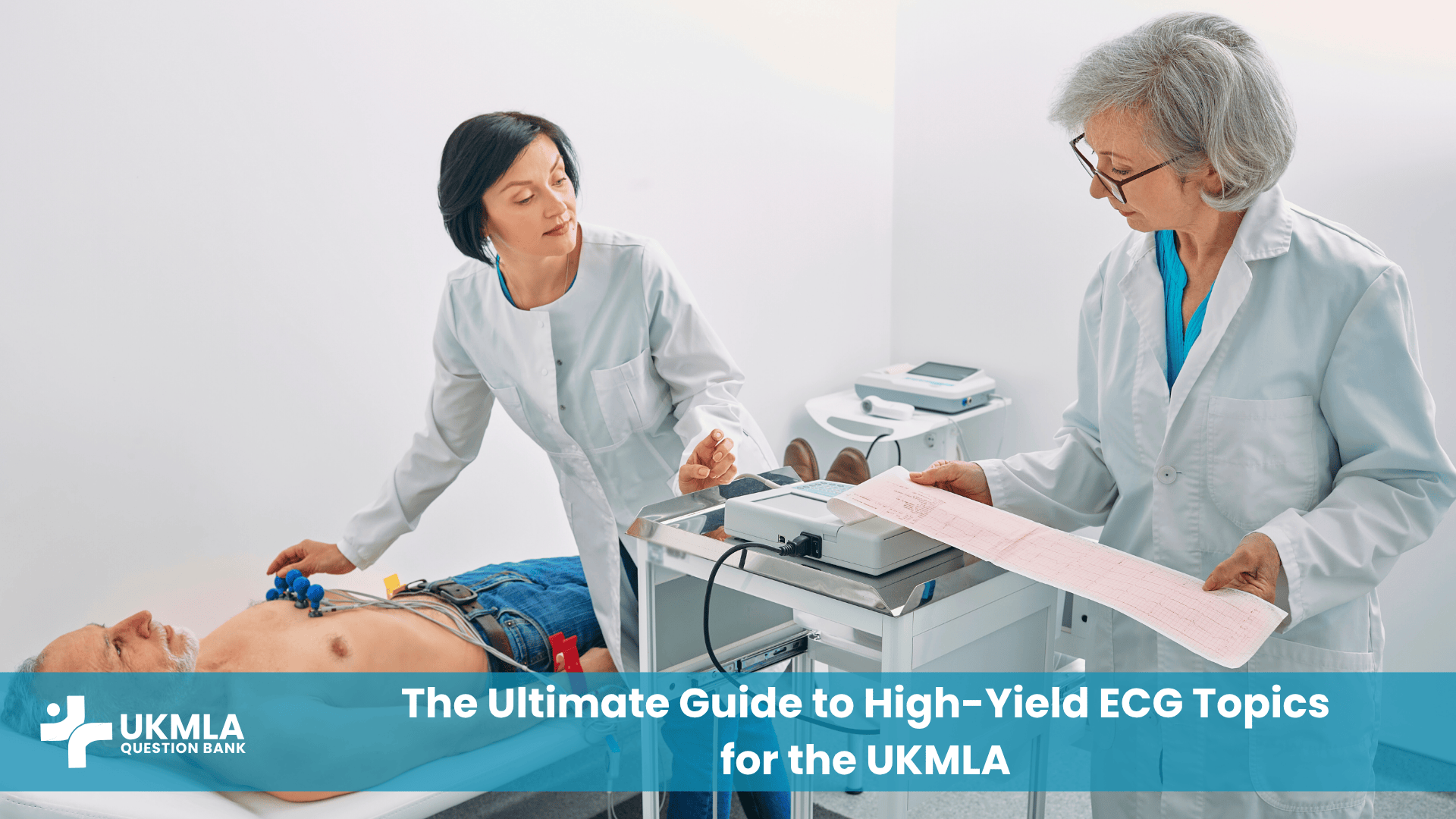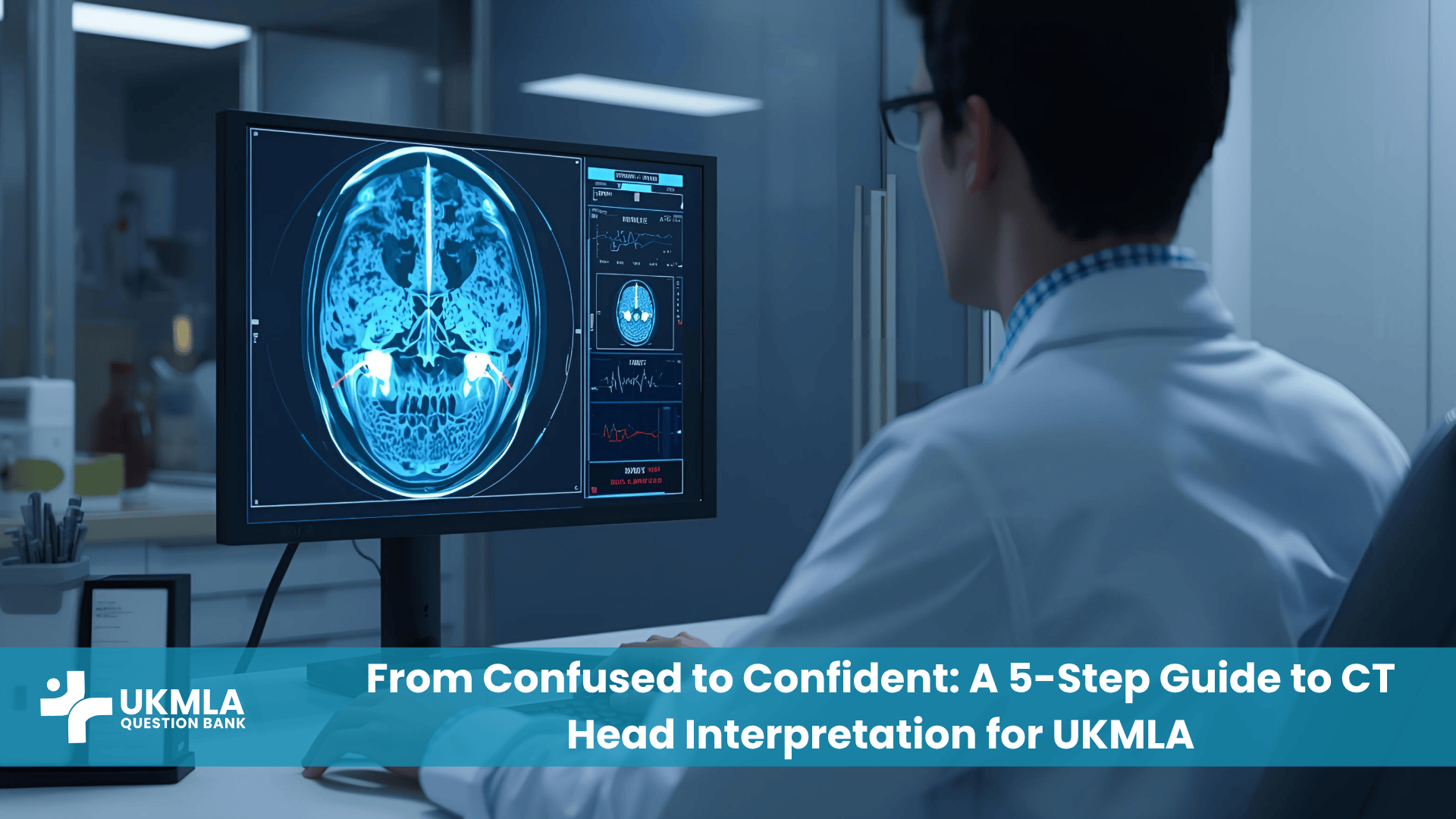Introduction
Mastering the most high-yield ECG topics for UKMLA is a critical step in preparing for the exam. Of all the clinical skills required, few are as universally important as electrocardiogram interpretation, which provides an invaluable window into a patient’s physiological state from cardiac emergencies to subtle electrolyte imbalances.
For many students and junior doctors, the squiggly lines can be intimidating. This guide is designed to change that. We will move beyond simple pattern recognition and provide a robust, systematic approach to analyzing any ECG, building your confidence and competence for this crucial component of the exam.
Table of Contents
ToggleThe 7-Step Method for ECG Interpretation
The key to avoiding errors is to use a structured, repeatable method every single time you look at an ECG. This systematic approach ensures you don’t miss crucial findings and is a cornerstone of interpreting clinical data for the UKMLA AKT.
Step 1: Rate (Is it Fast, Slow, or Normal?)
First, determine the heart rate. A normal heart rate is between 60-100 beats per minute (bpm). Tachycardia is >100 bpm, and bradycardia is <60 bpm. On a standard ECG (run at 25 mm/s), one large square is 0.2 seconds and one small square is 0.04 seconds.
The 300 Method (for regular rhythms): Count the number of large squares between two consecutive R waves and divide 300 by this number. For example, 4 large squares between R waves gives a rate of 300 / 4 = 75 bpm.
The 10-Second Strip Method (for irregular rhythms): Count the number of QRS complexes on the rhythm strip (which usually represents 10 seconds) and multiply by 6. This gives an average rate in beats per minute.
Step 2: Rhythm (Is it Regular or Irregular?)
Is the rhythm regular? Use a piece of paper or calipers to mark the R-R interval between two beats and see if it remains consistent across the strip. If it’s irregular, is there a pattern? A rhythm that is completely chaotic with no pattern is described as “irregularly irregular” and is the hallmark of atrial fibrillation.
Step 3: Axis (A Simple Guide to Determining Cardiac Axis)
Cardiac axis describes the overall direction of electrical activity in the heart’s frontal plane. A normal axis is between -30° and +90°. While complex calculations exist, a simple “quadrant” method is usually sufficient for the UKMLA. Look at the net QRS deflection (is it mostly positive or negative?) in leads I and aVF:
Normal Axis: QRS is positive (upright) in both Lead I and aVF.
Left Axis Deviation (LAD): QRS is positive in Lead I, negative in aVF. Think “Leaving” each other.
Right Axis Deviation (RAD): QRS is negative in Lead I, positive in aVF. Think “Reaching” for each other.
Step 4: P Waves (Are they Present? Are they Normal?)
The P wave represents atrial depolarisation. Ask yourself: Are P waves present? Is there one P wave for every QRS complex? Are they upright in lead II? Do they all look the same? The absence of P waves, replaced by a chaotic baseline, is a key feature of atrial fibrillation. Peaked P waves (P pulmonale) can suggest right atrial enlargement, while bifid P waves (P mitrale) can suggest left atrial enlargement.
Step 5: PR Interval (Is there a Delay?)
The PR interval is measured from the beginning of the P wave to the beginning of the QRS complex. It represents the time taken for the impulse to travel from the atria to the ventricles via the AV node. A normal PR interval is 0.12-0.20 seconds (3-5 small squares). A consistently prolonged PR interval (>0.20s) indicates a first-degree heart block.
Step 6: QRS Complex (Is it Broad or Narrow?)
The QRS complex represents ventricular depolarisation. Its duration is key. A normal QRS is narrow (<0.12s or 3 small squares).
A narrow QRS implies the impulse originated above the ventricles (supraventricular).
A broad QRS (>0.12s) suggests the impulse has a ventricular origin (e.g., ventricular tachycardia) or that there is a conduction delay in the ventricles, such as a bundle branch block.
Step 7: ST Segment, T Waves & QT Interval (Repolarisation)
This final step is crucial for spotting ischaemia, infarction, and dangerous electrolyte imbalances.
ST Segment: This should be isoelectric (flat on the baseline). Elevation or depression is abnormal.
T Waves: These represent ventricular repolarisation. They are normally upright except in aVR. Peaked T-waves or inverted T-waves are significant findings.
QT Interval: This represents the total time for ventricular depolarisation and repolarisation. A prolonged QT interval is dangerous as it increases the risk of life-threatening arrhythmias. This is a key concept in high-yield pharmacology for the UKMLA, as many medications can cause this.
Putting it Together: Analysing high-yield ecg topics for ukmla
Now, let’s apply our systematic approach to some of the most important patterns you’ll see in the exam. This is the core of any UKMLA cardiology essentials guide.
Myocardial Infarction: Spotting ST Elevation (STEMI)
An ST-Elevation Myocardial Infarction (STEMI) is a true medical emergency. You must be able to recognize it.
The Finding: ST segment elevation in two or more contiguous leads (leads that look at the same part of the heart). For example, ST elevation in leads II, III, and aVF indicates an inferior STEMI.
Management Context: Recognizing this is an immediate trigger for emergency cardiac intervention. This is a core part of the UKMLA emergency medicine essentials.
Atrial Fibrillation: The “Irregularly Irregular” Rhythm
Atrial Fibrillation (AF) is the most common sustained arrhythmia.
The Findings: An irregularly irregular rhythm, no P waves (often a fibrillatory baseline is seen), and a narrow QRS complex.
Heart Blocks: From First-Degree to Complete (Third-Degree)
Heart blocks are a common exam topic, representing a delay or failure of conduction through the AV node.
Clinical Pearl: The key to differentiating heart blocks is to meticulously analyze the relationship between the P waves and the QRS complexes.
Table 1: Differentiating the Main Types of Heart Block
| Type | PR Interval | P wave to QRS Ratio | Rhythm |
| First-Degree | Constantly prolonged (>0.20s) | 1:1 | Regular |
| Second-Degree (Mobitz I) | Progressively lengthens, then drops a beat | More P than QRS | Irregular |
| Second-Degree (Mobitz II) | Constantly normal or prolonged, then drops a beat | More P than QRS | Irregular |
| Third-Degree (Complete) | No relationship between P and QRS | More P than QRS | Regular |
Hyperkalemia: The Tall, Tented T-Waves
Electrolyte abnormalities have classic ECG findings. High potassium (hyperkalemia) is the most tested. The changes progress as potassium levels rise:
Tall, tented T-waves are the earliest sign.
Prolonged PR interval and flattening of the P wave.
Widening of the QRS complex.
Eventually, the QRS merges with the T-wave to form a “sine wave” pattern, heralding cardiac arrest.
Bundle Branch Blocks (RBBB and LBBB)
A bundle branch block is a delay in conduction down one of the main ventricular pathways. The key finding is a broad QRS complex (>0.12s).
Right Bundle Branch Block (RBBB): Look for an “M” shape in lead V1 and a “W” shape in lead V6. Think MaRRoW.
Left Bundle Branch Block (LBBB): Look for a “W” shape in lead V1 and an “M” shape in lead V6. Think WiLLiaM. A new LBBB is always considered pathological.
Wolff-Parkinson-White (WPW) Syndrome
WPW is a congenital condition where an “accessory pathway” allows the ventricles to pre-excite. It can lead to tachyarrhythmias.
The Findings: A short PR interval (<0.12s) and a delta wave (a slurred upstroke at the beginning of the QRS complex).
Pericarditis
Inflammation of the pericardium causes characteristic ECG changes that can be mistaken for a STEMI.
The Finding: Widespread, concave (“saddle-shaped”) ST elevation across multiple, non-contiguous leads. PR depression is also often seen. This contrasts with the localized, convex ST elevation seen in a STEMI.
Frequently Asked Questions (FAQ) about High-Yield ECG Topics for UKMLA
Look at leads I and aVF. If the QRS is upright in both, the axis is normal. If they are pointing away from each other (I up, aVF down), it’s left axis deviation. If they are pointing towards each other (I down, aVF up), it’s right axis deviation.
The classic findings are T-wave flattening, ST depression, and the appearance of a prominent U wave.
A STEMI shows ST-segment elevation. An NSTEMI (Non-ST-Elevation MI) will show other signs of ischaemia, such as ST depression or T-wave inversion, along with a rise in troponin.
A sawtooth pattern, especially in leads II and V1, is the classic sign of atrial flutter.
The simplest rule for the UKMLA is to look at the QRS width. A regular, broad-complex tachycardia is VT until proven otherwise. A regular, narrow-complex tachycardia is most likely SVT.
It’s a critical ECG pattern showing deep, biphasic T-wave inversion in leads V2-V3. It’s a sign of severe stenosis of the left anterior descending (LAD) coronary artery and signals an impending major anterior MI.
No. The UKMLA focuses on common and life-threatening conditions. You must be able to confidently identify MI, AF, common heart blocks, SVT vs. VT, and key electrolyte changes.
The best way is through repetition. Use online resources like the Life in the Fastlane (LITFL) ECG Library and practice with question banks that feature ECGs in their clinical vignettes.
The most common finding is a sinus tachycardia. The “classic” but rare S1Q3T3 pattern (a deep S wave in lead I, a Q wave in lead III, and an inverted T wave in lead III) may also be seen.
Check the patient’s name and date of birth to ensure it belongs to them, then immediately assess the patient themselves. Treat the patient, not just the ECG. For official UK guidance on arrhythmia management, refer to the Resuscitation Council UK (RCUK). and refer to the adult tachycardia algorithm.
Conclusion
ECG interpretation is a skill that transforms from daunting to manageable with a systematic approach and a focus on high-yield patterns. By consistently applying the 7-step method, you can deconstruct any ECG into its core components. Concentrate your efforts on mastering the classic presentations of life-threatening conditions like myocardial infarction, complete heart block, and hyperkalemia, as well as common patterns like atrial fibrillation and bundle branch blocks.
This structured approach will not only help you score marks in the UKMLA but will form the foundation of a crucial skill you will use every day as a competent and safe junior doctor in the UK. Your diligence in mastering this will pay dividends throughout your medical career.




